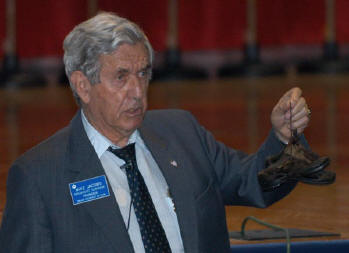|
 |
|
Here is some information on the Mauthausen
concentration camp: Mauthausen was located about 20km from Linz,
Austria. It was established in 1938. On May 5, 1945 Mauthausen
was liberated by the First Platoon of Troop D, But we'll get to that later.
The camp had an estimated number of 150,000 victims. Mauthausen had
about 10 sub-camps that lasted for some weeks, and 49 permanent sub-camps.
|
|
On August 8, 1938 Himmler
ordered a couple hundred prisoners to be transferred to the little town
of Mauthausen. There was a plan to build a new camp so they could supply
slave labor for the Wiener Grabben stone quarry. By 1939, most of
the prisoners were put to work building the camp and living quarters.
The main camp had 32 barracks surrounded by electric barbed wire fences.
There was also high stone walls and watch towers.
The
guards would torture the prisoners by making them climb the 186 steps of
Wiener Grabben with large blocks of granite on their backs. Often
the blocks would fall and crush the limbs of the prisoners behind.
The block's would even kill the prisoner. The SS guards would have a
competition to see who could get to the top first. The survivors
would be forced to jump off of the side of the quarry. That spot
is known as the "Parachute Jump." Prisoners would often get taken
to the top and would be told to fight. When two fighters fell, all
of the victors would be set free. |
 Mauthauen Mauthauen |
|
|
In 1941 a large number of Soviet
POWS attived at Mauthausen. The POWS were the first group to be
killed in the gas chamber in early 1942. The gas chambers had been
operated at Harthiem castle since 1948. The exhausted prisoners
would be transported to the Harthiem Castle. |
Mauthausen's Gates
|
|
|
In the time between 1940 and 1942,
many inmates weighed as mush as 90 lbs. Very few weighed 60 to 80 lbs.
Around six months was the average survival time at Mauthausen. The
Spanish Republican Army was most of the population. This is because they
were defeated by General Franco's Forces. The Spanish fled to France
and Germany. When France and Great Britain went to war with Germany,
most of the Spanish men fought on France's side. When France
surrendered the Spanish were taken as prisoners.
|
|
A large group of Hungarian and Dutch
Jews were transferred to Mauthausen. Most of the group died from the
hard work that they had to do. They also died from the poor
conditions. The prisoners would also get thrown off the sides of the
Mauthausen quarry! In the final months of the war, 20,000 prisoners
were transferred gron other camps to Mauthausen. |
|
Mauthausen had three main sections. Camp I was
the actual main camp. Camp II was the workshop area where prisoners
were forced to work. It was later converted to hold prisoners, in the
spring of 1944. Camp III was a Quartile camp built to separate incoming
prisoners from the main camp population. It was also built in 1944. |
|
Mauthausen held the record for
executions and deaths. Most died from the labor and others were put in
the gas chambers or shot. There was 200.000 prisoners that passed
through Mauthausen. 119,000 died with 38,120 Jews. These numbers
include the nearby Gusen camp. More inmates died there than than at
the main camp. On the trial, 58 defendants were found guilty and
received "The Death Sentence" and 3 received "Life In Prison." |
The killing of prisoners took place in
many different ways. In the SS they were beat, hung, shot, had administered
heart injections, poisoned with gas, froze to death, or died of hunger.
Prisoners were taken to Mauthausen because of their political activities,
religious beliefs, homosexuality, race, or because they were prisoners of
war.
|
There are lots
of survivors from the camp, but I'm only going to tell you a few.
Eva was born on April 29, 1945 at Mauthausen. Eva and her mother were
the only ones to survive out of 15 people in their family! Mike
Jacobs was a Jew from Konin, Poland. He was the founder of "Dallas
Memorial Center for Holocaust Studies." Jacobs now lives in Dallas
Texas. Sydney Fahn had been brought to Mauthausen from
Aushwitz-Berkenou and had weighed only 80lbs. She was so weak that
she couldn't even greet the US liberators.
|
 |
|


